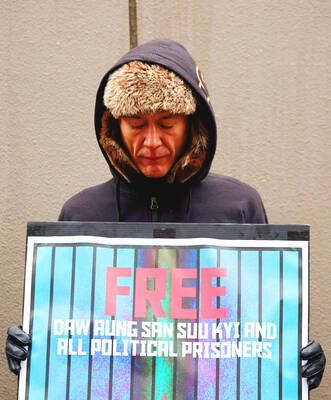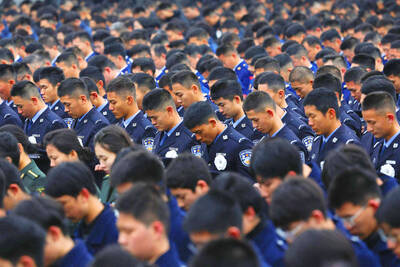The yellow-green streaks of fireflies that bring a magical air to summer nights, inspire camp songs and often end up in jars in children’s bedrooms may be flickering out in the backyards of the US as suburban sprawl encroaches on their habitats.
Scientists concerned by reports from the public that they are seeing fewer of the luminous insects each summer have turned to a network of backyard volunteers spanning much of the nation to track their range and numbers.
The Firefly Watch volunteers’ work is winding down now that the insects’ annual light show is over in all but southern states.
Helen Mester of South Bend, Indiana, is one of about 700 volunteers who entered observations this summer of firefly numbers, the color of their lights and flash patterns into the online database maintained by Firefly Watch, which is sponsored by the Boston Museum of Science.
The 54-year-old retiree has counted fireflies for three years for the program from her living room window or her deck.
About 200 firefly species found east of the Rocky Mountains produce, through a complex chemical reaction, lights ranging from yellow-green and yellow-amber to a pale blue. Light-producing fireflies aren’t found west of the Rockies.
Since the online Firefly Watch debuted in May 2008, about 5,100 people from 42 states have entered firefly data they collected in their yards, local parks and meadows, said Paul Fontaine, the Boston museum’s vice president of education.
Fontaine said the museum is committed to operating the program and database for at least 10 years to provide a year-to-year snapshot of firefly distribution.
The program, which also has volunteers in Canada, Costa Rica, Ghana and India, asks participants to watch fireflies for at least 10 minutes each week. Scientists at Massachusetts’ Fitchburg State University and Tufts University are helping with the project.
The data accumulating in the Firefly Watch database may help determine if fireflies are really declining, and if so where it’s happening and what could be causing it, said Christopher Cratsley, a Fitchburg biology professor who studies fireflies.
Cratsley said replacing meadows and fields with strip malls and parking lots clearly cuts firefly numbers. There is also evidence that the glare of streetlights that come with urban sprawl may interfere with the courtship of some firefly species by washing out their flashes.
He said pesticides, fertilizers and other chemicals could also kill the creatures that firefly larvae feed on, but the extent of that impact is unclear.
Georgia Southern University firefly researcher Jonathan Copeland believes the survey’s main contribution will be helping to pin down firefly species’ distribution. He said the question of whether firefly numbers were shrinking could only be answered by intensive study of specific locations over decades.
“The main value is if they are occurring and where they’re occurring,” said Copeland, a professor of biology.
San Antonio resident Denise Gregoire, who isn’t a Firefly Watch participant, lives in the same home where as a child she chased fireflies with friends. Nearly four decades after her parents moved to the home, the summer nights around it are devoid of fireflies.
Gregoire blames development — apartments, houses, a hospital complex — that replaced the fields that once surrounded her home, and the bright security lights that came with it.
“How are they going to eat, how are they going to survive, if all you’ve got is concrete?” said Gregoire, 48. “I guess they were decimated, because I don’t see them anymore.”
However, far from development, Firefly Watch observers like Steve Irvine still enjoy dazzling firefly displays.
Irvine, 57, has lived for more than three decades in a rural area of Ontario about 250km north of Toronto filled with fields and marshes. It’s a feast for firefly lovers.
Summertime visitors can step outside just after dusk and find themselves surrounded by tens of thousands of fireflies, blinking greenish-gold to a flickering orange.
“The fields around here are just alive with sparking light — it’s just magic. There’s countless thousands of them in the air. It’s just amazing,” Irvine said.

The Burmese junta has said that detained former leader Aung San Suu Kyi is “in good health,” a day after her son said he has received little information about the 80-year-old’s condition and fears she could die without him knowing. In an interview in Tokyo earlier this week, Kim Aris said he had not heard from his mother in years and believes she is being held incommunicado in the capital, Naypyidaw. Aung San Suu Kyi, a Nobel Peace Prize laureate, was detained after a 2021 military coup that ousted her elected civilian government and sparked a civil war. She is serving a

China yesterday held a low-key memorial ceremony for the 1937 Nanjing Massacre, with Chinese President Xi Jinping (習近平) not attending, despite a diplomatic crisis between Beijing and Tokyo over Taiwan. Beijing has raged at Tokyo since Japanese Prime Minister Sanae Takaichi last month said that a hypothetical Chinese attack on Taiwan could trigger a military response from Japan. China and Japan have long sparred over their painful history. China consistently reminds its people of the 1937 Nanjing Massacre, in which it says Japanese troops killed 300,000 people in what was then its capital. A post-World War II Allied tribunal put the death toll

‘NO AMNESTY’: Tens of thousands of people joined the rally against a bill that would slash the former president’s prison term; President Lula has said he would veto the bill Tens of thousands of Brazilians on Sunday demonstrated against a bill that advanced in Congress this week that would reduce the time former president Jair Bolsonaro spends behind bars following his sentence of more than 27 years for attempting a coup. Protests took place in the capital, Brasilia, and in other major cities across the nation, including Sao Paulo, Florianopolis, Salvador and Recife. On Copacabana’s boardwalk in Rio de Janeiro, crowds composed of left-wing voters chanted “No amnesty” and “Out with Hugo Motta,” a reference to the speaker of the lower house, which approved the bill on Wednesday last week. It is

FALLEN: The nine soldiers who were killed while carrying out combat and engineering tasks in Russia were given the title of Hero of the Democratic People’s Republic of Korea North Korean leader Kim Jong-un attended a welcoming ceremony for an army engineering unit that had returned home after carrying out duties in Russia, North Korean state media KCNA reported on Saturday. In a speech carried by KCNA, Kim praised officers and soldiers of the 528th Regiment of Engineers of the Korean People’s Army (KPA) for “heroic” conduct and “mass heroism” in fulfilling orders issued by the ruling Workers’ Party of Korea during a 120-day overseas deployment. Video footage released by North Korea showed uniformed soldiers disembarking from an aircraft, Kim hugging a soldier seated in a wheelchair, and soldiers and officials